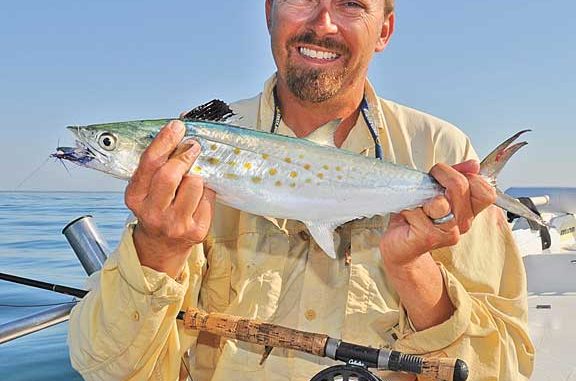
Diver’s Rock is a dependable spot for summer Spanish mackerel and bonito.
While many fishermen targeting Spanish mackerel head for the easier-to-access fishing near better-known inlets, at least one pair of Wilmington-area guides heads farther north for top-drawer action.
Towing a boat to Jacksonville, then heading down the New River to the ocean may seem like taking secrecy to the extreme, but Capt. Jamie Rushing and Capt. Blair White are playing hookie, trying to catch schooling fish without having to compete with dozens of other boats.
Instead, they head for the fertile fishing grounds just outside New River Inlet, which attract superior numbers of bigger fish, but fewer boats.
“I learned about Diver’s Rock a few years ago,” said Rushing, who operates Seagate Charters out of Wrightsville Beach. “New River offers an easy run if you stick to the channel markers, and once the Spanish and bonito bite tapers off when the sun gets high, you can always move back into the river to catch some trout, flounder and redfish on the way back home.”
Rushing guided his 21-foot Sea Pro bay boat through the inlet, which was in the process of being dredged by the U.S. Corps of Engineers, then had an oil-smooth ride across a couple of miles of ocean. The few boats that were fishing and diving seabirds directed him to a good place to start fishing before he’d passed the last navigation buoy.
“Diver’s Rock offers sight-fishing at its finest,” Rushing said. “We say we’re after Spanish mackerel, but the Atlantic bonito arrive first, around mid-April or early May. The Spanish arrive later, in May and June, and mix with the bonito. Bluefish may be here at any time, and you can always run into a school of false albacore. When you cast a lure beneath some of those birds circling overhead, you never really know what you’re going to catch. It might even be a big king mackerel.”
Rushing likes flat seas for the best sight-fishing. When it’s a bit rippled, or when he’s searching for concentrations of fish, he trolls deep-diving lures like the Yo-zuri Crystal Minnows. He also casts the deep divers along with some other double-duty lures, including jerkbaits like the Got-Cha.
“What I’m trying to do is find a big concentration of fish,” he said. “Some anglers use up their fishing time chasing a surfacing school here or there, only to stop and begin casting and find the fish have sounded or left the area. They may catch a fish or two, but if they would just be patient and watch the ocean for a few minutes while trolling around, they would have much better luck.”
White operates Tightline Fishing Charters and, like Rushing, has fished the area for several years. He stood on the bow with rod in hand, watching for fish as Rushing trolled the area. Rushing reeled in a bonito and a Spanish mackerel as they shared notes on what they were seeing.
Eventually, they agreed on a spot to try sight-casting, a spot that was literally boiling with fish when they arrived. What had appeared to be small pods of widely-separated fish turned out to be a solid school of mixed bluefish, bonito and Spanish mackerel covering a couple of acres.
“Now we’re going to get into some action,” White said. “When it’s this good, you can cast in any direction and hook a fish.”
Before Rushing left the steering console, White set the hook on a big Spanish mackerel, using the diving lure he had been trolling moments before, casting it and retrieving it as fast as he could reel to incite the fish into striking.
“You can’t reel a lure too fast to take it away from a Spanish mackerel, bonito or bluefish,” he said. “The faster you can reel it, the better. But cranking the big-lipped diving lures can also wear you out.”
“I like using metal spoons,” Rushing said. “There are all manner of them on the market these days. They’re called casting spoons or jigging spoons, and all of them will catch a Spanish mackerel. The best finishes are those that are the shiniest. Most of the time, color won’t make that much of a difference, but I do like using blue, silver, gold and hot pink. That’s a pretty broad spectrum of colors.”
Rushing said the best tactic during calm days is watching the fish for a few minutes to see where they’re heading, then trying to ease his boat ahead of the fish before shutting down the outboard and allowing the boat to drift into the school on the wind or current.
“There’s always wind or current, but it may be very slight,” he said. “You use what you have to your advantage. You don’t want to rev the motor or switch it on or off when you’re approaching a school or in the middle of it. Sudden changes in background noise frighten the fish.”
Rushing and White caught a dozen fish apiece from the school before it appeared to disappear. But rather than start the motor and begin chasing other visible fish in the distance, they bided their time, continuing to cast to individual fish that surfaced sporadically around the boat.
“Usually, the fish have just gone deep following the baitfish,” White said. “I cast to any place where I see a disturbance. Another thing to watch are the birds. The gulls and terns circle above fish too deep in the water for them to reach with a dive. But if you cast a spoon or jerkbait below them, odds are you’re going to bang a fish on the nose if you let the lure sink before you begin retrieving it.”
Once he had enough of catching the 2- to 4-pound Spanish on spinning gear, Rushing put together an 8-weight fly rod. He tied on a short, 30-pound mono leader and a blue and white Clouser fly.
“I use the same leader with a fly as I do when I’m trolling or casting a lure,” he said. “I figure if the fish can’t see it or bite through it when it’s ahead of a lure, it will work just as well with a fly. I catch plenty of Spanish mackerel with a heavier leader than most fly fishermen use, but flies are expensive, and I also don’t want to lose the fish or the fly because of a tooth-cut leader.”
Rushing caught a Spanish mackerel on his first cast — a somewhat unusual reward.
“Sometimes, the fish won’t strike a fly because you can’t fish it fast enough to interest them,” he said. “I’ve had times when the only way to hook them was to put the rod beneath your arm or between your legs and haul the line in hand-over-hand as fast as you can. Other times, like today, all you have to do is hit the water with the fly to get a strike.”
White stuck with his spinning gear. One fly fisherman on the boat at one time is enough, he said, or tangles could ensue when the action was hot. He was using a 6- to 12-pound combo: a 6½-foot Shimano spinning rod and a Shimano Stradic 3000 reel spooled with Power Pro braid.
“I use 6-pound diameter, 20-pound test braided line,” he said. “I can cast the braid a country mile to reach surfacing fish, and the low stretch allows me to feel the strike quickly and set the hook faster than with mono. It’s also more abrasion resistant, which saves lots of lures and lost fish. When using mono, I’ve had the line suddenly go slack, losing lure and all. A fish may have struck the line or the leader knot, or just cut it as he went by. Spanish, bluefish and bonito all have extremely sharp teeth. With mono, one little nick and it’s all over. But braid withstands anything but a solid bite.”

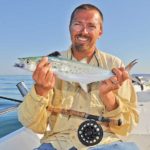
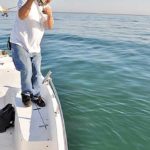

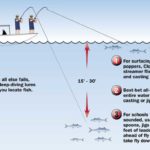
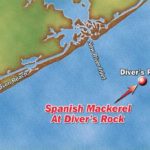



Be the first to comment